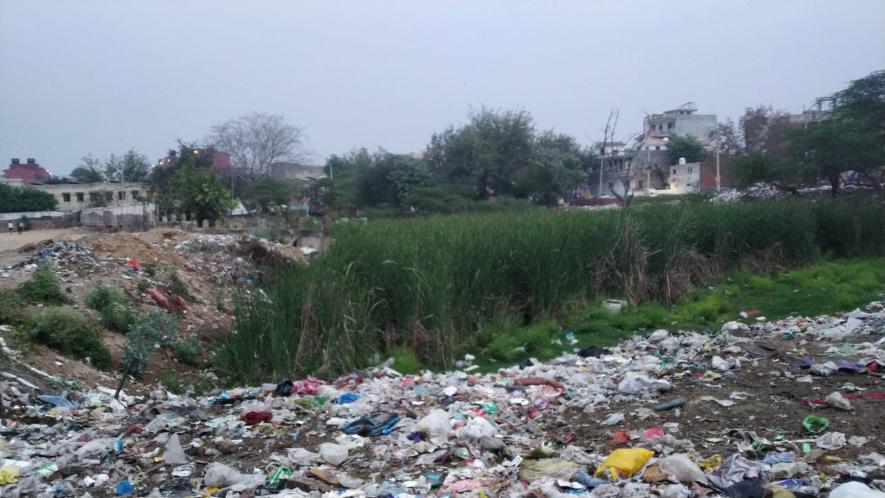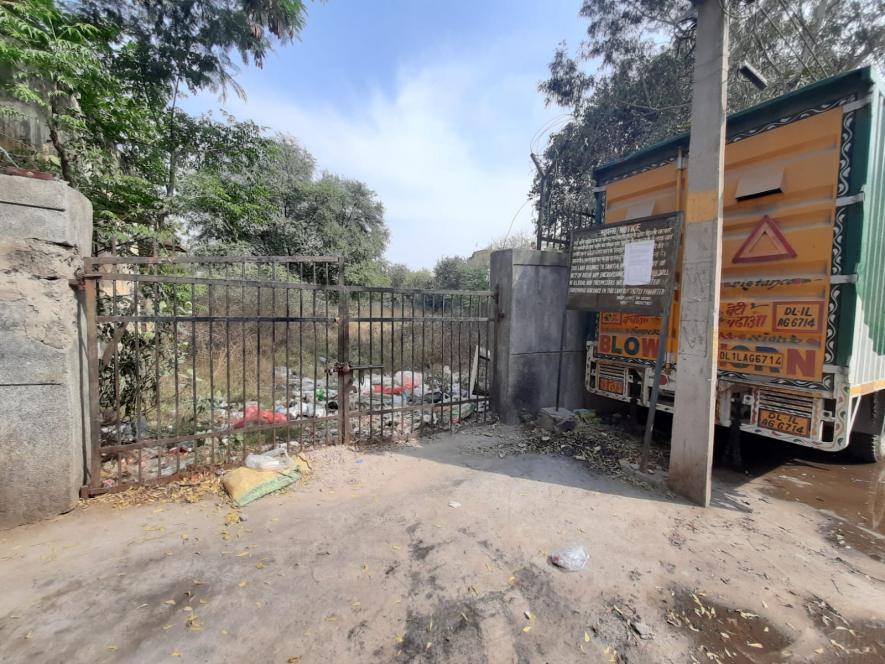Delhi’s Disappearing Ponds, Waterless Villages -- Victims of Unplanned Urbanisation

Asola's pond land, now a barren land, where some of the land has been captured by the locals and the rest is full of garbage.
New Delhi: With rapid urbanisation in the national capital, the stereotypical image of villages has disappeared, and so have the local water bodies, small ponds, and rivulets that were once major water sources for these areas.
In Vikaspuri’s Budhela village, a new phenomenon has emerged, as most of the landowners have started selling off land and house owners are mostly renting out their buildings. This is largely happening due to lack of drinking water, as the locals have to rely on tankers for water.
“The tanker does not come every day. It sometimes skips a day, and sometimes even more. When it misses more than a day, we have no option but to rely on the untimely tap water, which is not very healthy to drink,” an elderly man, who has lived all his life in Budhela, told NewsClick.
As soon as one visits the area, one is welcomed by flies and mosquitoes. Amid the lack of groundwater, people also live in extremely unhygienic conditions.
Residents narrated how one political party after other has come into power, and local representatives have paid them visits, but no concrete solution has yet been provided to the residents. After walking about half a kilometre into the village, there lies an area surrounded by a boundary wall of about 12 ft, making the insides of the ground invisible unless one reaches the main gate. Right behind the gate lies a puddle of waste and garbage. One the side, a board mentions the details about the land.
“This land belongs to the Sahitya Kala Parishad, Govt of NCT, Delhi. Any encroachment of the land is illegal and trespassers shall be penalised. Throwing garbage on this land is strictly prohibited,” reads the board.
Ironically, right beside this board is the main gate, behind which lies the garbage, throwing which is “strictly prohibited”. The entire ground is full of garbage, shrubs, and plants.
“This once used to be a pond; one of the four ponds that our village belt had,” said Deepak Tyagi, a local who was present there. “Cattle would come here for water, kids would play around, and the local people would sit here during the evenings. Now, it is just a barren land given to a government entity,” he added. Deepak said he was born and brought up in the neighbourhood, and knew every nook and corner of the village.
Budhela village is primarily dominated by the Tyagis, and the land was taken by the government back in the 1960s. The villagers have seen it all, starting from the time when they would go to a Lalaji (grocery owner) to get pulses and sugar in exchange for the wheat they had grown, to having their land being taken by the government and farming coming to an end.

The Budhela pond land. The main gate from where the entire area has been made restricted
“I am talking about the time when our people had no knowledge about the land price. They were too poor, and any money sounded good to them. As a result, the government took their land by giving them a meagre compensation of Rs1/guj,” Deepak told NewsClick.
Later, in the late 1980s, Deepak recalled that the pond slowly started drying up. After a while, the pond land became a debris site for all nearby construction work, and soon it was filled with mud and waste.
Deepak said when the land was recognised as pond land, then the government should use it for that purpose. “Our people do not have any source of recreation. If the government constructs an artificial pond, people will automatically stop depositing waste there. Also, the elderly and children would have a place to sit and play in the evenings. Rainwater can be easily stored and used later in times of crisis as well,” he said.
The story does not end here. Budhela has a lot of vacant government land. One of these has been allocated to a hospital, another for an auditorium, and in a few other places, there are either empty buildings or barren stretches of land. All these are in prime locations of the area. However, the only land that the government found usable by the Sahitya Kala Parishad was the one inside the village where the residents stay, and the land was denoted as a pond.
Since the Delhi Development Authority (DDA) is a Central agency, the tussle of the villagers is now with the Central government.
‘No Pond as Result of AAP-BJP Conflict’
Far away from Budhela, Asola is a village in South Delhi’s Chhatarpur that almost touches the Haryana border. The village is one of its kind, according to the residents. “We have been the most oppressed in entire Delhi. Starting from taking away of our forest land to the lack of basic necessities,” said some of the villagers.
Himmat Singh, a 55-year-old resident of the village, who was born and brought up there, has seen the area transform. However, there is a difference here in terms of the usually claimed modernisation. “When other villages transformed, they became a part of the cityscape. Even today, we remain a ‘kasba’,” he said.
In the 1980s, villages in the Asola belt used to come under the Gram Sabha. Naturally, the land was used by the villagers to earn a living. A pond used to be the source of water for the people who indulged in animal husbandry and was also of immense use in times of crisis. Rainwater was easily collected in the pond. “Today, there is no pond, and to add to our problems, the groundwater level has gone down at least by 300 ft, and in some areas, there is no water even below 400 ft,” Singh told NewsClick.

With no sign of water, Illegal buildings seem to have been constructed, and the place is now a home to stray animals
Before the Delhi Assembly elections in 2020, in the name of urbanisation, the land in Asola was acquired by DDA. Since the land is under the DDA, which comes under the Central government, the local MLAs say they cannot help the villagers. Every time the villagers go with a complaint to the MLA, he lsays that even if they are ready to work, the DDA objects saying that the land comes under its authority. “Right now, all they are doing is playing a blame game. But, when the land was under them, they did not do a thing either,” he added.
Another resident, 33-year-old Ansh Tanwar, has always seen low water level in the area. Although he said he does remember taking an occasional swim in the pond with his friends as a child. The water level was not good even then, he told NewsClick. Ansh works as a real estate agent.
With the ponds gone, and farmland taken, the people have been left with no choice but to put an end to cattle-rearing and farming. After this, most of the villagers started to rely on the youth getting private jobs, while the elderly were left with no choice but to stay at home.
With the land and water of Asola going under DDA’s control, the villagers watched in helplessness, as there were stories of better treatment being shown by the Haryana government on that side of the same forest region. The land in the border villages still comes under the Gram Sabha, and is used by villagers for farming, and other personal uses.
“There are times when we do not have water for 8-10 days. For many days, the water that comes from the Delhi water supply smells foul and pungent and is not fit for drinking. In such situations, we are compelled to get water from tankers or buy 20 litre cans for drinking water,” Tanwar said.
For the villages of South Delhi, the problems are bigger because of inaccessibility to natural resources and government benefits. The nearest Metro station from Asola is 5km away. The lack of water in the ponds has compelled them to procure water from other sources. Borewells have started to fail in the past few years and the forest land that once belonged to the villagers will soon become part of a wildlife sanctuary inaccessible to them.
Court Orders and Differing Govt Response
In 2013 and 2022, the Delhi High Court, in different matters, had observed that encroachment of pond land was illegal, and the encroachers were to be punished. In an order dated November 14, 2000, the time when villages were moving toward urbanisation and land was being taken away, the Development Department of the Delhi government issued an order that accepted that the pond lands in the NCT (National Capital Territory) were being captured or being used for different purposes. However, these ponds were supposed to be water sources for the locals.
In the case of Budhela village, there are contradicting responses from the state and Central government departments. On one hand, the DDA (under Central government) says that the land belongs to Sahitya Kala Parishad, for which re-tendering was done recently. On the other hand, the Development Department of the Delhi government, in the order from 2000, recognised that the pond land was not supposed to be used for any other purpose but for the welfare of the Gram Sabhas there.

The Board put up by the govt that narrates about how the land belongs to the Sahitya Kala Parishad and throwing any garbage is strictly prohibited
As per a survey done by the CYCLE Foundation (Centre for Youth Culture Law and Environment), a total of 1,001 ponds in Delhi were surveyed. In this survey, it was found that 302 water bodies were encroached upon either by government agencies or private individuals. Another 100 were contaminated by sewage and garbage, while 345 were completely dry.
The "City of Lakes" project, which aims to restore and create new water bodies, is now being carried out by the Delhi government. A similar strategy has been suggested by the Delhi Wetlands Authority.
Nevertheless, an analysis of these plans and conversations with the officials concerned shows that there is no coordination between them and any plan to restore encroached water bodies has probably not reached the drawing board as yet.
Get the latest reports & analysis with people's perspective on Protests, movements & deep analytical videos, discussions of the current affairs in your Telegram app. Subscribe to NewsClick's Telegram channel & get Real-Time updates on stories, as they get published on our website.






















